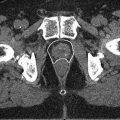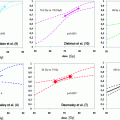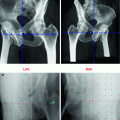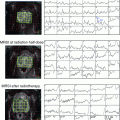Trial
Eligibility
Arms
DFS (%)
OS (%)
RTOG 85-31
T3 or T1-2,
N+ or pT3
RT versus RT + ADT
10 years
23 versus 37
(P < 0.0001)
10 years
39 versus 49
(P = 0.002)
RTOG 86-10
T2b-4, N+
RT versus RT + NHT
10 years
3 versus 11
(P < 0.001)
10 years
34 versus 43
(P = 0.12)
RTOG 92-02
T2c-4, N+
sPSA < 150 ng/mL
RT + NHT
versus RT + NHT + ADT
5 years
28.1 versus 46.4
(P < 0.001)
5-years
78.5 versus 80
(P = 0.73)
RTOG 94-13
T2c-4, N+
risk > 15 %
WP + NHT
WP + ADT
PO + NHT
4 years
59.6
48.9
4 years
84.7 versus 84.3
(P = 0.73)
T94-0110
T3
ADT + RT versus ADT
7 years
74 versus 66
p = 0.0033
EORTC
22,863
T3-4 or T1-2
WHO 3
RT versus RT + ADT
5 years
45 versus 74
(P < 0.001)
5 years
62 versus 78
(P = 0 .002)
SPCG-7
T2-3, pN0
PSA < 70 ng/mL
AA versus RT + AA
10 years
29.6 versus 39.4
RTOG 86-10 assessed the impact of ADT before and concurrent with RT (Pilepich et al. 2001). In that study, 471 men were randomly assigned to EBRT with or without ADT plus flutamide between 1987 and 1991. ADT was administered for 2 months before and 2 months during EBRT. Patients with bulky tumors with or without lymph node affection and no sign of M+ disease were eligible. At a median follow-up of 12.5 years, 456 patients were evaluated. The median survival time was increased from 7.7 to 8.7 years. ADT significantly decreased the rates of disease-specific mortality (35 % vs. 47 %, p = 0.006), increased disease-free survival (11 % vs. 3 %), and overall survival (43 % vs. 34 %, Table 1).
Still, the clinical benefit was seen in Gleason score 2–6 tumors only, and not in patients diagnosed with a Gleason score of 7–10.
In the EORTC 22,863, Bolla et al. assessed the role of adjuvant ADT in high-risk patients (Bolla et al. 1997). Patients in the adjuvant ADT arm received androgen suppression on the first day of EBRT, and continued for 3 years. Follow-up was 66 months and 484 patients were included. At 5 years the disease-free survival was 74 % versus 40 % with ADT and without ADT and overall survival 78 % versus 62 % in the combined arm versus EBRT alone (p = 0.001).
In the post-PSA era, several randomized trials have been conducted by the RTOG. RTOG 92-02 investigated the impact of neoadjuvant and concomitant ADT (4 months totally) and the same radiotherapy in addition to 2 years of adjuvant ADT (Hanks et al. 2003). Median follow-up was 5.8 years, patients with long-term ADT experienced a statistically significant improvement for all endpoints compared to short-term ADT. Overall, a 10 % overall survival advantage for those patients with a high Gleason score 8–10 and a longer course of ADT versus short-term course of ADT was reported.
RTOG 94-13 compared two different sequencing regimes of adjuvant ADT as well as the role of whole pelvic EBRT (Lawton et al. 2007). This study was designed to investigate if whole pelvis EBRT followed by a boost to the prostate achieves a progression-free survival of at least 10 % compared to ADT and EBRT to the prostate only. Due to unsuspected hormone/radiation interactions the verdict is still not settled.
The EORTC 22,961 enrolled 970 patients with locally advanced PCa to either 6 months of ADT and 70 Gy or 3 years of ADT plus 70 Gy (Bolla et al. 2009). Despite improved progression-free survival in the long course ADT arm, there were no overall survival differences so far.
In the SPCG-7 phase III trial the effect of endocrine therapy alone compared to endocrine therapy combined with EBRT (range 70–74 Gy) was assessed (Widmark et al. 2009). From 1996 to 2002, 875 patients with locally advanced PCa (T3; 78 %) were randomized to endocrine treatment alone (3 months of total androgen blockage followed by continuous endocrine treatment using flutamide or to endocrine treatment combined with EBRT). The primary endpoint was PCSS. At a median follow-up of 7.6 years, this study showed an absolute 12 % difference in mortality in favor of the combined arm (23.9 % vs. 11.9 %, CI 4.9–19.1, relative risk = 0.44). The overall mortality was halved at 10 years for prostate cancer-specific death.
The National Cancer Institute of Canada-Clinical Trials Group/Southwest Oncology Group T94-0110 trial showed a significant reduction in the mortality risks with the addition of RT to ADT after median follow-up of 7 years (overall survival 74 % with ADT + EBRT compared to 66 % to ADT, p = 0.0033) (Warde et al. 2011). This trial included 1,205 patients and provides convincing evidence that local control disease in the prostate improves survival in patients with locally advanced PCa. Interestingly, treatment-induced morbidity was not substantially different from the toxicity seen in the ADT-only cohort.
Also, in earlier stage of PCa the influence of ADT was investigated. D’Amico et al. designed a study testing 70 Gy plus 6 months of ADT versus EBRT alone for patients with intermediate risk (D’Amico et al. 2008). At a median follow-up of 4.5 years they found an overall survival advantage at 5 years for the combined group (88 % vs. 78 %, p = 0.04).
The results of seven published prospective randomized trials are acknowledged in Table 1.
3.2 HDR-Brachytherapy and LDR-Brachytherapy Outcome
For intermediate and high-risk disease there are concerns that BT alone may not adequately treat the periprostatic tissues and micrometastic spread nearby, and therefore, it may be used optimally as a boost in combination with EBRT and ADT in prognostically high-risk patients. It also has a potential biological advantage through the delivery of high doses per fraction. Dose escalation is feasible by combining RT with high-dose rate after loading BT, which provides optimal intensity-modulated conformal radiation dose delivery (Morris et al. 2013; Kuban and Dong 2004; Martinez et al. 2003). Hoskins’ group recently published their findings applying neoadjuvant ADT to 76 % of their patients and adjuvant ADT to almost all high-risk patients, and they could demonstrate a significant dose–response relationship in the HDR-BT/EBRT arm (EBRT 35.75 Gy + HDR-BT 8.5 Gy × 2) resulting in improved 31 % reduction in the risk of recurrence compared to RT alone after a median observation time of 7.1 years (Hoskin et al. 2012). Trimodality therapy, a concept including ADT, RT, and a brachytherapy boost technique, administered in one recent population showed a favorable 5-year OS estimate (96 %) in comparison with published reports on OS in similar series employing only EBRT ± ADT (Lilleby et al. 2012). Lilleby et al. found a high rate of PCSS (99.3 %, see Table 2) compared with other series, conducted in a group of high-risk patients after a median follow-up of 44.2 months (Lilleby et al. 2012). The rigorous surgical staging procedures confirming pN0 status in most of the treated patients may have contributed to these excellent results. Still, only prospectively randomized trials can clarify the beneficial role of long-term ADT with HDR-BT + EBRT compared to ADT + EBRT in high-risk patients.
Table 2
Comparison of outcome in patients treated with high-dose-rate-brachytherapy boost actuarial 5-year estimates
Reference | Risk group | No. of patients | bNED (%) | DFS (%) | PCSS (%) | OS (%) | Period (months) |
|---|---|---|---|---|---|---|---|
Åstrøm et al. | All High Intermediate Low | 214 47 87 80 | 82 56 87 92 | 91 80 93 94 | 97 86 100 100 | 89 74 92 94 | 48a |
Galalae et al. | All High Intermediate Low | 588 354 188 46 | 77 69 88 96 | 67 61 75 83 | 96 95 99 100 | 85 85 86 88 | 60b |
Martinez et al. | All High Intermediate Low | 207 35 75 97 | 74 50 75 85 | 68 41 72 77 | 98 97 97 100 | 92 91 93 92 | 58b |
Lilleby et al. | All High Intermediate | 275 256 19 | 98.5 98.8 100 | 95.6 95.2 100 | 99.3 99.6 96 | 96.3 96.8 92 | 42a |
Phan et al. | All High Intermediate Low | 309
Stay updated, free articles. Join our Telegram channel
Full access? Get Clinical Tree
 Get Clinical Tree app for offline access
Get Clinical Tree app for offline access

|




